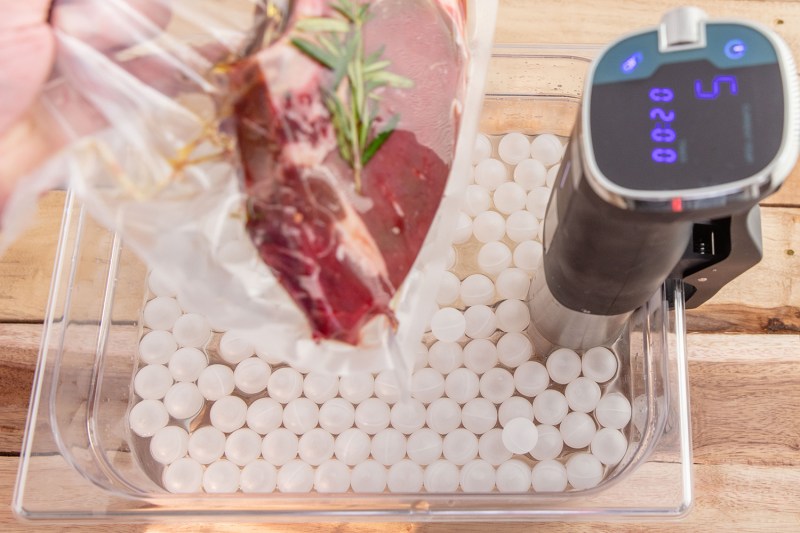If you’ve ever dined at a fancy French restaurant and wondered how the chefs there cooked a slab of meat to tender perfection, they’re probably using the sous vide method. Sous vide translates to “under vacuum” and involves cooking foods using a pot of water and a vacuum-sealed bag. It is a trendy culinary technique, for sure.
But did you know that it originates from an old-school method? We’re not going to spoil everything, because Tyson Ho, who was formerly the chef and owner of Arrogant Swine in New York City, spills all the most important details on everything you need to know about sous vide cooking. While Chef Ho no longer operates at this establishment, his expert insight is still incredibly useful to anyone looking to incorporate this technique into their arsenal. While you’re at it, don’t forget to head on over to our roundup of the best sous vide machines if you want to pair your newfound knowledge with the equipment you’ll need to execute this method. Now, let’s explore so you can answer the question, “What is sous vide cooking?”
The hype behind the method

The Manual (TM): It’s strange to think boiling a steak would lead to a perfect result — can you explain some of the science behind the sous vide method?
Tyson Ho (TH): Sous vide demystifies most of meat cookery. The craft of the cook is the subjugation of fire to maintain a temperature. This is very hard to do; fire is an ancient and violently unstable god. Sous vide eliminates the need to master cookery because a set temperature is at your fingertips.
Sous vide allows for meat to hit a desired temperature and go no further, defanging the threat of overcooking. It does this by slowly raising the internal temperature of the meat in a stable and controlled environment i.e., the water bath. Its creation is no less pivotal than the lever and pulley were for the caveman.
What’s the history behind sous vide?

TM: How long has this cooking method been around?
TH: Sous vide is a fairly recent cooking method that, in my opinion, evolved from the classic French technique: En vessie. En Vessie was a technique of slow cooking popularized by the father of modern French cuisine, Fernand Point (1897-1955). When a dish is cooked en vessie, the animal is placed inside a pig’s bladder and seasoned with aromatics like truffles and boosted with aromatic liquor like cognac, sherry, or Madeira.
The bladder is tied and set over simmering waters, where it would balloon up slowly, cooking chicken or poultry in its natural juices. The underlying theory became mainstream. Gentle cooking of meat resulted in a product that was more tender and juicy.
Is it becoming a trend?

TM: Do you get the sense many restaurants and/or chefs are using sous vide?
TH: Sous vide is largely relegated to high-end restaurants and most chefs avoid it because of the extra administrative requirements to legally use sous vide. The technique is not one that our modern health departments understand and so many unnecessary fines have scared off chefs.
TM: Is there anything we can’t cook via sous vide?
TH: Barbecue. Like Flat Earth theorists, there are some who believe that barbecue can be cooked sous vide. And just like flat earth theorists, to design to their thoughts is nothing short of irrational.
TM: How difficult is it to master?
TH: [It’s] a device so easy a child could cook meat at the precision of a Michelin-star chef.
Take it from Tyson

In the end, sous vide isn’t just a flashy trend you’ll only find behind the scenes of fine dining kitchens — it’s an underrated technique that’s rooted in culinary tradition and backed by some serious science. As Chef Tyson Ho explained, it takes the guesswork out of cooking meat by keeping temperatures stable and precise, ensuring whatever protein you cook hits the right level of doneness every time without the risk of overcooking. From its origins in the elegant French en vessie method to its modern transformation into a plug-and-play kitchen tool, sous vide has quietly revolutionized the way we think about temperature, tenderness, and technique.
While it may not be a go-to for barbecue (and Chef Ho is hilariously firm on that), it opens up a world of possibilities for home cooks looking to elevate their meals with minimal effort. It doesn’t matter whether you’re new to the method or just looking to refine your skills, sous vide is as beginner friendly as it is professional grade. As long as you arm yourself with a little guidance and the right equipment, you’ll be serving perfectly cooked meats worthy of a Michelin star in no time.



